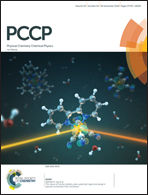Shock wave propagation, plasticity, and void collapse in open-cell nanoporous Ta†
Abstract
We systematically investigate the wave propagation, plasticity and void collapse, as well as the effects of porosity, specific surface area and impact velocity, in a set of open-cell nanoporous Ta, during shock compression, via performing large-scale non-equilibrium molecular dynamics simulations. The shock wave propagation presents an impedance, sensitive to porosity, but not to specific surface area. Such surprising phenomena are due to the similar sensitivities in density and stress variations to porosity or specific surface area. Upon impact, shock front shapes change from ramped to steep ones, with increasing porosity, specific surface area or impact velocity, owing to the transition from the heterogeneous to homogeneous plasticity along transverse directions. This transition of plasticity arises by (i) the strong impedance on large deformation bands as porosity increases; and (ii) the transition from deformation twinning to dislocation slips, and to amorphization, as the specific surface area or impact velocity increases. Shock-induced plasticity, including their nucleation, growth and interactions, also facilitates the collapse of voids.



 Please wait while we load your content...
Please wait while we load your content...